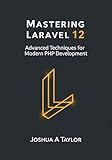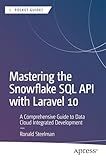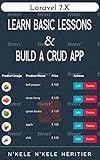Best Laravel Timestamp Comparison Tools to Buy in December 2025

Laravel: Up & Running: A Framework for Building Modern PHP Apps



Laravel 12 for Beginners & Beyond: A Complete Guide to Building Modern PHP Web Applications with Clean Architecture, Hands-On Projects, and Best Practices



Mastering Laravel 12 : Advanced Techniques for Modern PHP Development



Mastering the Snowflake SQL API with Laravel 10: A Comprehensive Guide to Data Cloud Integrated Development (Apress Pocket Guides)



Architecture of complex web applications. Second Edition.: With examples in Laravel(PHP)



Laravel 7.X : LEARN BASIC LESSONS & BUILD A CRUD APP (PHP Framework)



The Laravel Survival Guide: Written & Updated for Laravel 5.3


In Laravel, you can compare the created_at timestamp with a Carbon date by first retrieving the model instance and accessing the created_at timestamp attribute. You can then use the Carbon date instance to compare with the created_at timestamp using the diff() or greaterThanOrEqualTo() methods provided by Carbon.
Here is an example of how you can compare a created_at timestamp with a Carbon date in Laravel:
use App\Models\YourModel; use Carbon\Carbon;
// Retrieve the model instance $model = YourModel::find(1);
// Get the created_at timestamp $createdAtTimestamp = $model->created_at;
// Create a Carbon date instance $carbonDate = Carbon::now();
// Compare the created_at timestamp with the Carbon date if ($createdAtTimestamp->greaterThanOrEqualTo($carbonDate)) { // Do something if the created_at timestamp is greater than or equal to the Carbon date } else { // Do something if the created_at timestamp is less than the Carbon date }
By following this example, you can easily compare a created_at timestamp with a Carbon date in Laravel.
How to add years to a date in Laravel?
In Laravel, you can easily add years to a date using the Carbon package which comes included in Laravel.
Here's an example of how you can add years to a date in Laravel:
use Carbon\Carbon;
$date = Carbon::parse('2022-05-20'); $newDate = $date->addYears(5);
echo $newDate; // Output: 2027-05-20
In this example, we first create a new Carbon instance from the initial date '2022-05-20'. Then, we use the addYears() method to add 5 years to the date. Finally, we output the new date which is '2027-05-20'.
You can also chain multiple methods together like this:
$newDate = Carbon::parse('2022-05-20')->addYears(5);
echo $newDate; // Output: 2027-05-20
This will achieve the same result in a more concise way.
How to check if a date is in the future in Laravel?
To check if a date is in the future in Laravel, you can use the Carbon library which comes pre-installed with Laravel.
Here is an example code snippet showing how you can check if a date is in the future:
use Carbon\Carbon;
$date = Carbon::parse('2022-12-31');
if ($date->isFuture()) { echo 'The date is in the future'; } else { echo 'The date is not in the future'; }
In this code snippet, we first parse the date string '2022-12-31' into a Carbon object. Then, we use the isFuture() method provided by the Carbon library to check if the date is in the future. If the date is in the future, it will output 'The date is in the future'. Otherwise, it will output 'The date is not in the future'.
How to get the difference in seconds between two dates in Laravel?
In Laravel, you can calculate the difference in seconds between two dates using the diffInSeconds() method available in the Carbon library. Here's an example of how to do this:
use Carbon\Carbon;
// Create two Carbon date objects $date1 = Carbon::parse('2022-01-01 00:00:00'); $date2 = Carbon::parse('2022-01-01 00:05:00');
// Calculate the difference in seconds between the two dates $diffInSeconds = $date1->diffInSeconds($date2);
echo $diffInSeconds; // Output: 300 seconds
In this example, we first create two Carbon date objects for the two dates we want to compare. We then use the diffInSeconds() method on the first date object, passing in the second date object as an argument. This method will return the difference in seconds between the two dates.
You can customize this code to fit your specific needs, such as using different date formats or including time zones.
What is the best practice for comparing created_at timestamp with a Carbon date in Laravel?
The best practice for comparing a created_at timestamp with a Carbon date in Laravel is to use the Carbon instance provided by Laravel's Eloquent model.
You can access the created_at timestamp directly on an Eloquent model instance like this:
$createdAt = $model->created_at;
Then, you can create a new Carbon instance with the desired datetime and compare it with the created_at timestamp like this:
$carbonDate = Carbon::parse('2022-01-01 00:00:00'); if ($createdAt->greaterThan($carbonDate)) { // do something }
This way, you can easily compare the created_at timestamp with the Carbon date and perform necessary actions based on the comparison result.
How to check if a date is before another date in Laravel?
In Laravel, you can use the Carbon library to easily work with dates and perform date comparisons. Here's an example of how you can check if a date is before another date in Laravel:
use Carbon\Carbon;
$date1 = Carbon::parse('2021-01-20'); $date2 = Carbon::parse('2021-01-25');
if ($date1->lt($date2)) { // Date 1 is before Date 2 echo 'Date 1 is before Date 2'; } else { // Date 1 is not before Date 2 echo 'Date 1 is not before Date 2'; }
In this example, we first create two Carbon objects representing the dates we want to compare. We then use the lt() method to check if Date 1 is before Date 2. If Date 1 is before Date 2, the condition will be true and we can output a message accordingly.
You can also use other comparison methods provided by the Carbon library, such as gt() for greater than, lte() for less than or equal to, and gte() for greater than or equal to, depending on your specific requirements.
